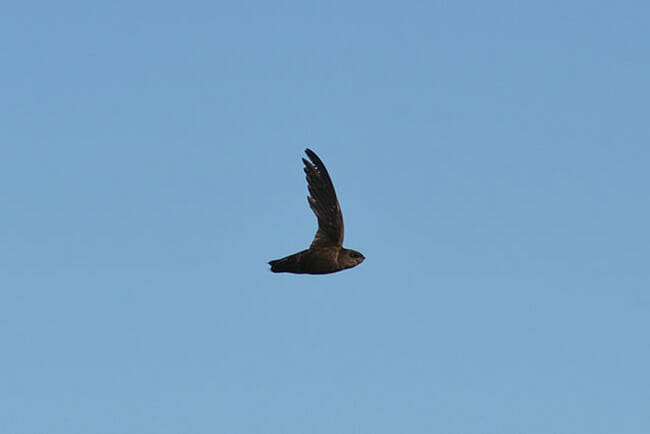

Uh oh...
It appears that you're using a severely outdated version of Safari on Windows. Many features won't work correctly, and functionality can't be guaranteed. Please try viewing this website in Edge, Mozilla, Chrome, or another modern browser. Sorry for any inconvenience this may have caused!
Read More about this safari issue.
James Diedrick from Decatur, USA, CC BY 2.0

With over 400 species of birds in Arkansas, it can be hard to determine which bird you are seeing in your backyard. With this guide, you can identify the flying friend that is coming to your bird feeder and understand what food that specific bird is looking for. If you are lucky enough to hear their song or call, you can check this guide to identify the bird you are hearing.
Be sure to notice the coloring of the bird in your backyard, it could be an immature, female or male bird of a species. Although you may be seeing these birds in your backyard, they have other homes (habitats) as well.
Here is your guide to the Backyard Birds of Arkansas: Summer residents!

Courtesy of Mike Wintroath/ Arkansas Game and Fish Commission
Ruby-throated Hummingbird (Archilochus colubris)
The ruby-throated hummingbird is the most common hummingbird in Arkansas. Although other species have been seen, they are not common. To spot the difference between a male and a female, look to see if there is a red patch on the throat. Females lack this red patch, whereas males have an iridescent red throat. These hummingbirds have a slightly downcurved bill that is slender.
Size: 3 3/4″
Food: Spiders and tiny insects (gnats, flies, etc.)
Habitat: Forest edges, gardens, parks and backyards
Song: High-pitched, raspy twitterings

Young, Female Summer Tanager. Mike Wintroath/ Arkansas Game and Fish Commission
Summer Tanager (Piranga rubra)
There are plenty of red birds to look for in your backyard during the summer, but the Summer Tanager is the only completely red bird in all of North America. If you see a red bird with a gray-brown bill, you are looking at a male summer tanager. The female is yellowish with dark wings and a light bill.
Size: 7 3/4″
Food: Bees and wasps
Habitat: Short and open woodlands
Song: Varied whistles and chuckling noises. Call is a “pik-l-tuk-l-tuk.”

Wildreturn, CC BY 2.0, via Wikimedia Commons
Indigo Bunting (Passerina cyanea)
You can easily spot a male Indigo Bunting because they are bright blue with dark wings and a dark, conical bill. The female is brown with a dark, conical bill so that they can better hide from predators.
Size: 5 1/2″
Food: Seeds and insects
Habitat: Overgrown patches, low edges and brushy roadsides
Song: Lively song that sounds like “tsee tsee tew tew cheer cheer” and their call is a staccato “zip.”

Andrew C, CC BY 2.0, via Wikimedia Commons
Painted Bunting (Passerina ciris)
Similar to the Indigo Bunting, the Painted Bunting females are dull green with a gray bill so that they aren’t easily seen. The males are brightly colored with a blue head, red below and a light green back and wings. These birds are stocky and have stubby bills for eating seeds.
Size: 5 1/2″
Food: Seeds and insects
Habitat: Dense brush
Song: Call is a staccato “chich.”

Ursus sapien, CC BY-SA 4.0, via Wikimedia Commons
Purple Martin (Progne subis)
The male Purple Martin is dark bluish-purple with black wings and a tail. Whereas, female Purple Martins have a duller back, tail and wings, along with a gray-flecked chest and head.
Size: 8″
Food: Flying insects like wasps, winged ants and the occasional bee
Habitat: Since these are colonial birds, they nest with dozens of martins in open areas, usually near a body of water.
Song: Call sounds like “sher-sher.”

Photo courtesy of Thomas Redd
Barn Swallow (Hirundo rustica)
Barn swallows, or mud nesters, build their nests out of mud around buildings and bridges. The males and females look very similar, except that males have longer tails. They are glossy blue and black above with orange below and a long, black forked tail.
Size: 6 3/4″
Food: Flying insects like house flies, horse flies, wild bees and beetles.
Habitat: Barn Swallows are known for being adaptive, so they live in open habitats such as fields, parks and meadows, but they can be found inside sheds, barns and bridges.
Song: Twittery notes, interrupted with rattling

Andrew C, CC BY 2.0, via Wikimedia Commons
Chimney Swift (Chaetura pelagica)
Chimney swifts are just like they sound, they nest in chimneys or hollow trees. The sticks they use to build these nests get stuck together by a substance produced in the bird’s mouth. A chimney swift is a gray-brown bird with a short tail and long, pointed wings. Their body is tube-shaped with long curved wings.
Size: 5 1/4″
Food: Flying insects like stoneflies, beetles, fleas, ants, wasps and bees
Habitat: You guessed it, Chimney Swifts live in chimneys or other vertical dim, enclosed areas.
Song: Rolling and twittering “chitter-chitter-chitter”
This guide was completed with the help of the Arkansas Game and Fish Commission’s “Arkansas Backyard Birds” booklet. You can get your own booklet by contacting the Arkansas Game and Fish Commission on their website or calling (833) 345-0325.
Join the Conversation
Leave a Comment
2 responses to “Arkansas Backyard Birds: Summer Residents”
 Leave a Reply
Leave a Reply
We do the work.
You check your email.
Sign up for our weekly e-news.
Get stories sent straight to your inbox!











 Leave a Reply
Leave a Reply
[…] here to learn more about Arkansas backyard […]
[…] are active in the winter and are likely to be seen flying around during colder months. While our summer residents migrate to warmer climates, these birds stay around in our backyards during the cold season. To […]